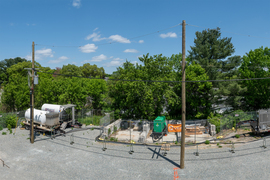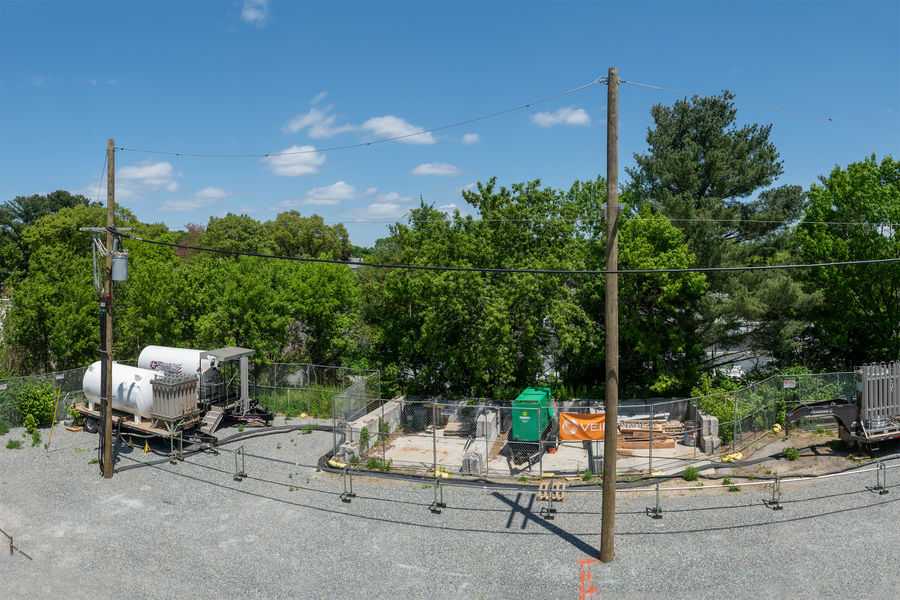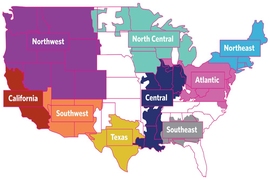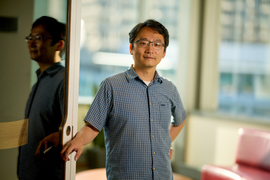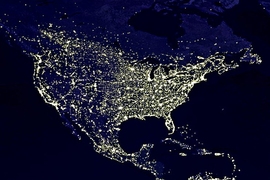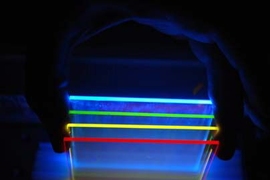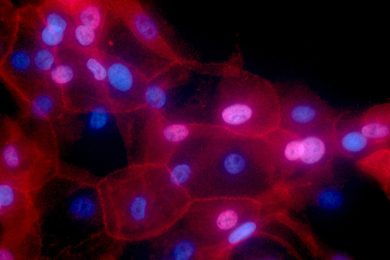Last year in Woburn, Massachusetts, a power line was deployed across a 100-foot stretch of land. Passersby wouldn’t have found much interesting about the installation: The line was supported by standard utility poles, the likes of which most of us have driven by millions of times. In fact, the familiarity of the sight is a key part of the technology’s promise.
The lines are designed to transport five to 10 times the amount of power of conventional transmission lines, using essentially the same footprint and voltage level. That will be key to helping them overcome the regulatory hurdles and community opposition that has made increasing transmission capacity nearly impossible across large swaths of the globe, particularly in America and Europe, where new power distribution systems play a vital role in the shift to renewable energy and the resilience of the grid.
The lines are the product of years of work by the startup VEIR, which was co-founded by Tim Heidel ’05, MEng ’06, SM ’09, PhD ’10. They make use of superconducting cables and a proprietary cooling system that will enable initial transmission capacity up to 400 megawatts and, in future versions, up to several gigawatts.
“We can deploy much higher power levels at much lower voltage, and so we can deploy the same high power but with a footprint and visual impact that is far less intrusive, and therefore can overcome a lot of the public opposition as well as siting and permitting barriers,” Heidel says.
VEIR’s solution comes at a time when more than 10,000 renewable energy projects at various stages of development are seeking permission to connect to U.S. grids. The White House has said the U.S. must more than double existing regional transmission capacity in order to reach 2035 decarbonization goals.
All of this comes as electricity demand is skyrocketing amid the increasing use of data centers and AI, and the electrification of everything from passenger vehicles to home heating systems.
Despite those trends, building high-power transmission lines remains stubbornly difficult.
“Building high-power transmission infrastructure can take a decade or more, and there’s been quite a few examples of projects that folks have had to abandon because they realize that there's just so much opposition, or there’s too much complexity to pull it off cost effectively,” Heidel says. “We can drop down in voltage but carry the same amount of power because we can build systems that operate at much higher current levels, and that’s how our lines are able to melt into the background and avoid the same opposition.”
Heidel says VEIR has built a pipeline of interested customers including utilities, data center operators, industrial companies, and renewable energy developers. VEIR is aiming to complete its first commercial-scale pilot carrying high power in 2026.
A career in energy
Over more than a decade at MIT, Heidel went from learning about the fundamentals of electrical engineering to studying the electric grid and the power sector more broadly. That journey included earning a bachelor’s, master’s, and PhD from MIT’s Department of Electrical Engineering and Computer Science as well as a master’s in MIT’s Technology and Policy Program, which he earned while working toward his PhD.
“I got the energy bug and started to focus exclusively on energy and climate in graduate school,” Heidel says.
Following his PhD, Heidel was named research director of MIT’s Future of the Electric Grid study, which was completed in 2011.
“That was a fantastic opportunity at the outset of my career to survey the entire landscape and understand challenges facing the power grid and the power sector more broadly,” Heidel says. “It gave me a good foundation for understanding the grid, how it works, who’s involved, how decisions get made, how expansion works, and it looked out over the next 30 years.”
After leaving MIT, Heidel worked at the Department of Energy’s Advanced Research Projects Agency-Energy (ARPA-E) and then at Bill Gates’ Breakthrough Energy Ventures (BEV) investment firm, where he continued studying transmission.
“Just about every single decarbonization scenario and study that’s been published in the last two decades concludes that to achieve aggressive greenhouse gas emissions reductions, we’re going to have to double or triple the scale of power grids around the world,” Heidel says. “But when we looked at the data on how fast grids were being expanded, the ease with which transmission lines could be built, the cost of building new transmission, just about every indicator was heading in the wrong direction. Transmission was getting more expensive over time and taking longer to build. We desperately need to find a new solution.”
Unlike traditional transmission lines made from steel and aluminum, VEIR’s transmission lines leverage decades of progress in the development of high-temperature superconducting tapes and other materials. Some of that progress has been driven by the nuclear fusion industry, which incorporates superconducting materials into some of their nuclear reactor designs.
But the core innovation at VEIR is the cooling system. VEIR co-founder and advisor Steve Ashworth developed the rough idea for the cooling system more than 15 years ago at Los Alamos National Laboratory as part of a larger Department of Energy-funded research project. When the project was shut down, the idea was largely forgotten.
Heidel and others at Breakthrough Energy Ventures became aware of the innovation in 2019 while researching transmission. Today VEIR’s system is passively cooled with nitrogen, which runs through a vacuum-insulated pipe that surrounds a superconducting cable. Heat exchange units are also used on some transmission towers.
Heidel says transmission lines designed to carry that much power are typically far bigger than VEIR’s design, and other attempts at shrinking the footprint of high-power lines were limited to short distances underground.
“High power requires high voltage, and high voltage requires tall towers and wide right of ways, and those tall towers and those wide right of ways are deeply unpopular,” Heidel says. “That is a universal truth across just about the entire world.”
Moving power around the world
VEIR’s first alternating current (AC) overhead product line is capable of transmission capacities up to 400 megawatts and voltages of up to 69 kilovolts, and the company plans to scale to higher voltage and higher-power products in the future, including direct current (DC) lines.
VEIR will sell its equipment to the companies installing transmission lines, with a primary focus on the U.S. market.
In the longer term, Heidel believes VEIR’s technology is needed as soon as possible to meet rising electricity demands and new renewable energy projects around the globe.

